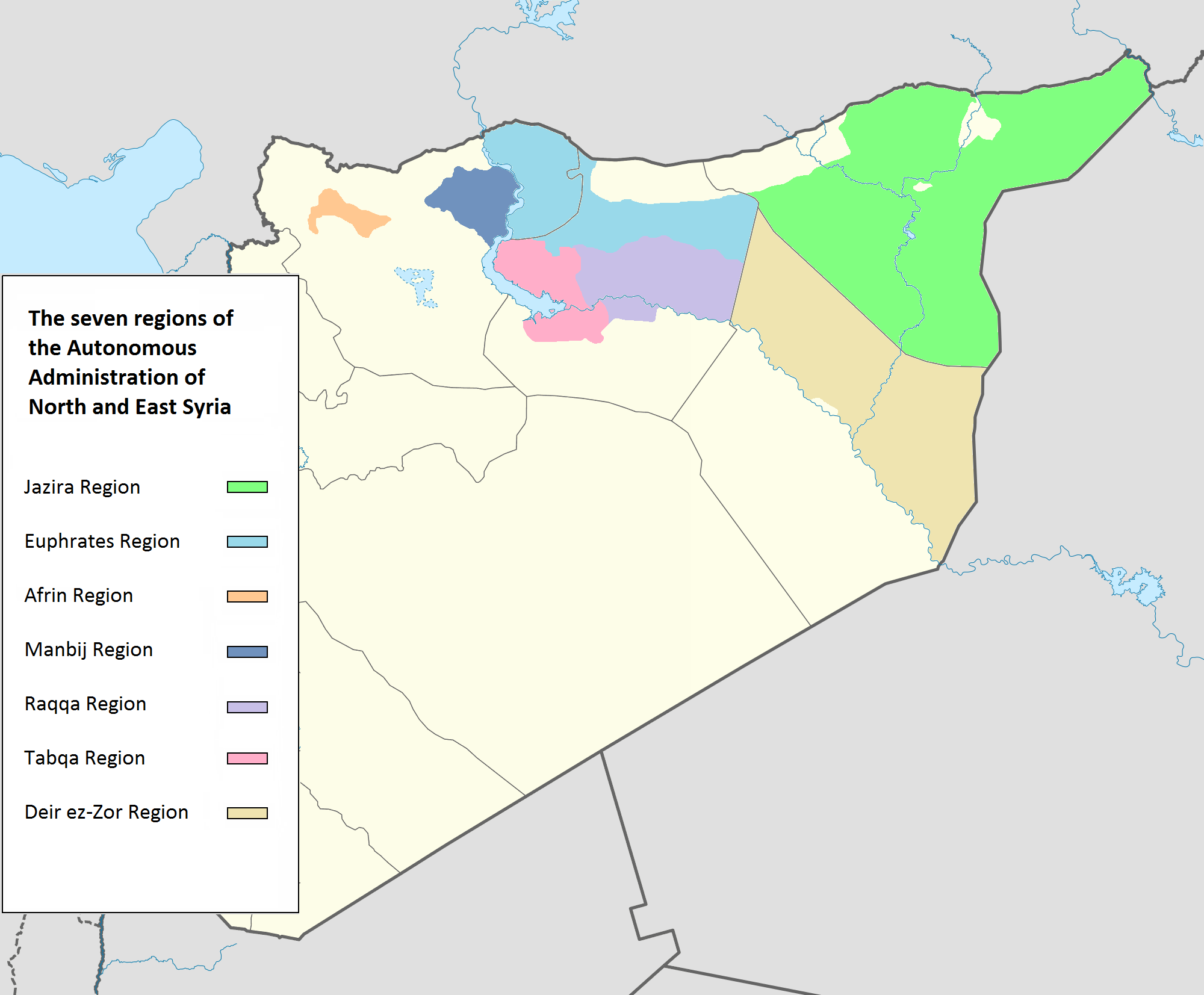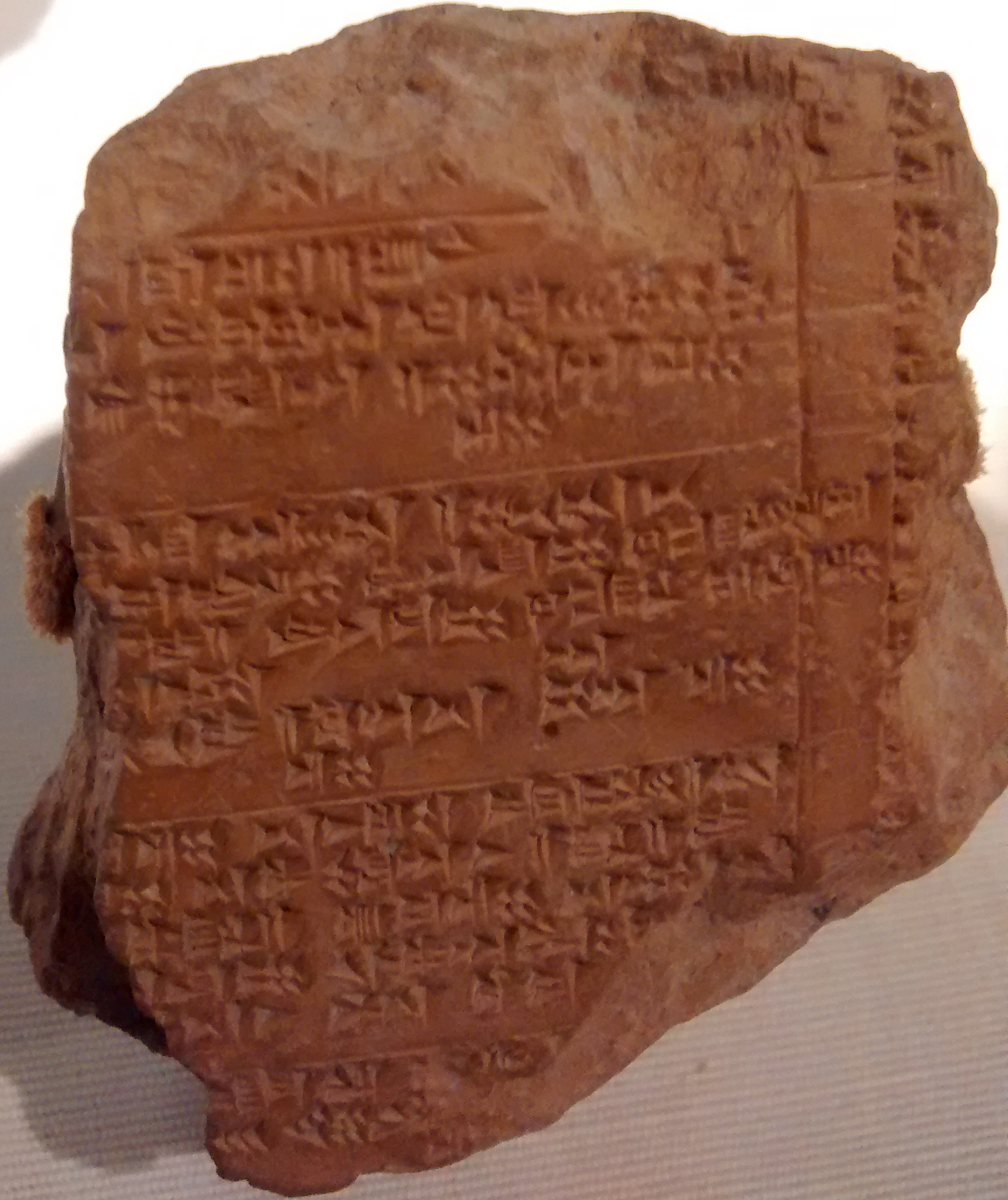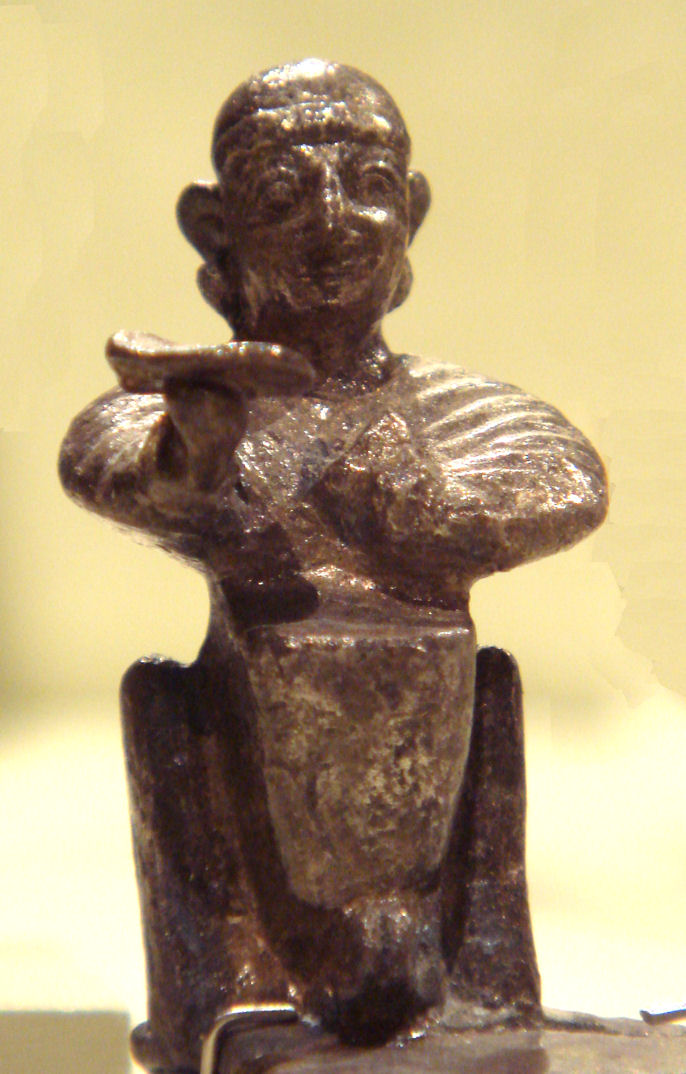|
Aleppo Treaty
The Aleppo Treaty ( CTH 75) is a 13th Century BCE document created by Hittite King Muwatalli II, consisting of a copy of an earlier treaty made between Talmi-Šarruma, King of Aleppo, and Muwatalli II's father and predecessor, Muršili II. According to the text of the treaty, Muwatalli II reissued it because the original copy of the treaty was stolen. The text of the treaty was preserved in several archival copies on clay cuneiform tablets written in Akkadian. The tablets were found in Bogazkale, Turkey, the site of ancient Hattuša. The most complete copy of the treaty is held by the British Museum. The treaty is considered a "goldmine of information on the relations among Hatti, Mittani and Aleppo" during the Bronze Age. Background Talmi-Šarruma was a grandson of Šuppiluliuma I and thus a cousin of Muwatalli II and a nephew of Muršili II. The treaty contains a mutual loyalty clause referencing this family connection, reading, "For we are all the descendants of Šuppi ... [...More Info...] [...Related Items...] OR: [Wikipedia] [Google] [Baidu] |
Aleppo Treaty - Hittites
Aleppo is a city in Syria, which serves as the capital of the Aleppo Governorate, the most populous Governorates of Syria, governorate of Syria. With an estimated population of 2,098,000 residents it is Syria's largest city by urban area, and was the largest by population until it was surpassed by Damascus, the capital of Syria. Aleppo is also the largest city in Syria's Governorates of Syria, northern governorates and one of the List of largest cities in the Levant region by population, largest cities in the Levant region. Aleppo is one of List of cities by time of continuous habitation#West Asia, the oldest continuously inhabited cities in the world; it may have been inhabited since the sixth millennium BC. Excavations at Tell as-Sawda and Tell al-Ansari, just south of the old city of Aleppo, show that the area was occupied by Amorites by the latter part of the third millennium BC. That is also the time at which Aleppo is first mentioned in cuneiform tablets unearthed in Ebl ... [...More Info...] [...Related Items...] OR: [Wikipedia] [Google] [Baidu] |
Mittani
Mitanni (–1260 BC), earlier called Ḫabigalbat in old Babylonian texts, ; Hanigalbat or Hani-Rabbat in Assyrian records, or in Egyptian texts, was a Hurrian-speaking state in northern Syria and southeast Anatolia (modern-day Turkey) with Indo-Aryan linguistic and political influences. Since no histories, royal annals or chronicles have yet been found in its excavated sites, knowledge about Mitanni is sparse compared to the other powers in the area, and dependent on what its neighbours commented in their texts. The Hurrians were in the region as of the late 3rd millennium BC. A king of Urkesh with a Hurrian name, Tupkish, was found on a clay sealing dated at Tell Mozan.Salvini, Mirjo. "The earliest evidences of the Hurrians before the formation of the reign of Mittanni." Urkesh and the Hurrians Studies in Honor of Lloyd Cotsen. Urkesh/Mozan Studies Bibliotheca Mesopotamica. Malibu: Undena Publications (1998): 99-115 The first recorded inscription of their language was of ... [...More Info...] [...Related Items...] OR: [Wikipedia] [Google] [Baidu] |
Hittite Texts
The corpus of texts written in the Hittite language consists of more than 30,000 tablets or fragments that have been excavated from the royal archives of the capital of the Hittite Kingdom, Hattusa, close to the modern Turkish town of Boğazkale or Boğazköy. While Hattusa has yielded the majority of tablets, other sites where they have been found include: Maşat Höyük, Ortaköy, Kuşaklı or Kayalıpınar in Turkey, Alalakh, Ugarit and Emar in Syria, Amarna in Egypt. The tablets are mostly conserved in the Turkish museums of Ankara, Istanbul, Boğazkale and Çorum (Ortaköy) as well as in international museums such as the Pergamonmuseum in Berlin, the British Museum in London and the Musée du Louvre The Louvre ( ), or the Louvre Museum ( ), is a national art museum in Paris, France, and one of the most famous museums in the world. It is located on the Rive Droite, Right Bank of the Seine in the city's 1st arrondissement of Paris, 1st arron ... in Paris. The corp ... [...More Info...] [...Related Items...] OR: [Wikipedia] [Google] [Baidu] |
Hittite Religion
Hittite mythology and Hittite religion were the religion, religious beliefs and practices of the Hittites, who created an empire centered in Anatolia from . Most of the narratives embodying Hittite mythology are lost, and the elements that would give a balanced view of Hittite religion are lacking among the tablets recovered at the Hittite capital Hattusa and other Hittite sites. Thus, "there are no canonical scriptures, no theological disquisitions or discourses, no aids to private devotion". Some religious documents formed part of the corpus with which young scribes were trained, and have survived, most of them dating from the last several decades before the final burning of the sites. The scribes in the royal administration, some of whose archives survive, were a bureaucracy, organizing and maintaining royal responsibilities in areas that would be considered part of religion today: temple organization, Cult (religion), cultic administration, reports of diviners, make up the ... [...More Info...] [...Related Items...] OR: [Wikipedia] [Google] [Baidu] |
Mitanni
Mitanni (–1260 BC), earlier called Ḫabigalbat in old Babylonian texts, ; Hanigalbat or Hani-Rabbat in Assyrian records, or in Ancient Egypt, Egyptian texts, was a Hurrian language, Hurrian-speaking state in northern Syria (region), Syria and southeast Anatolia (modern-day Turkey) with Indo-Aryan languages, Indo-Aryan Indo-Aryan superstrate in Mitanni, linguistic and political influences. Since no histories, royal annals or chronicles have yet been found in its excavated sites, knowledge about Mitanni is sparse compared to the other powers in the area, and dependent on what its neighbours commented in their texts. The Hurrians were in the region as of the late 3rd millennium BC. A king of Urkesh with a Hurrian name, Tupkish, was found on a clay sealing dated at Tell Mozan.Salvini, Mirjo. "The earliest evidences of the Hurrians before the formation of the reign of Mittanni." Urkesh and the Hurrians Studies in Honor of Lloyd Cotsen. Urkesh/Mozan Studies Bibliotheca Mesopotamic ... [...More Info...] [...Related Items...] OR: [Wikipedia] [Google] [Baidu] |
Tudhaliya I
Tudḫaliya is the name of several Hittite kings or royals. It is not clear how many kings bore that name, and numbering schemes vary from source to source. *Tudḫaliya (sometimes called Tudḫaliya I) is deduced from his early placement in a later offering list as a hypothetical pre-Empire king who might have reigned in the early 17th century BC. * Tudḫaliya I (sometimes considered identical with the following, as Tudḫaliya I/II ), ruled in the mid-15th century BC, son of Kantuzzili. * Tudḫaliya II (sometimes considered identical with the preceding, as Tudḫaliya I/II or renumbered as Tudḫaliya I ), ruled at the start of the 14th century BC, father-in-law of Arnuwanda I. * Tudḫaliya III (sometimes renumbered as Tudḫaliya II ), in the early 14th century BC, the son of Arnuwanda I and predecessor of Šuppiluliuma I. * Tudḫaliya the Younger (sometimes numbered as Tudḫaliya III ), in the mid-14th century BC, the son of Tudḫaliya III, he probably never reigned. * ... [...More Info...] [...Related Items...] OR: [Wikipedia] [Google] [Baidu] |
Mursili I
Mursili I (also known as Mursilis; sometimes transcribed as Murshili) was a king of the Hittites 1620-1590 BC, as per the middle chronology, the most accepted chronology in our times (or alternatively c. 1556–1526 BC, short chronology), and was likely a grandson of his predecessor, Hattusili I. His sister was Ḫarapšili and his wife was queen Kali. Accession Mursili came to the throne as a minor. Having reached adulthood, he renewed Hattusili I's warfare in northern Syria. Campaigns Conquest of Yamhad (Aleppo) He conquered the kingdom of Yamhad and its capital, Aleppo, which had eluded Hattusili. He then led an unprecedented march of 2,000 km south into the heart of Mesopotamia, where in 1595 BC he sacked the city of Babylon. Mursili's motivation for attacking Babylon remains unclear, though William Broad has proposed that the reason was obtaining grain because the clouds from the Thera eruption decreased the Hittites' harvests. Sack of Babylon The raid on ... [...More Info...] [...Related Items...] OR: [Wikipedia] [Google] [Baidu] |
Yamhad
Yamhad (Yamḫad) was an ancient Semitic languages, Semitic-speaking kingdom centered on Ḥalab (Aleppo) in Syria (region), Syria. The kingdom emerged at the end of the 19th century BC and was ruled by the Yamhad dynasty, who counted on both military and diplomacy to expand their realm. From the beginning of its establishment, the kingdom withstood the aggressions of its neighbors Mari, Syria, Mari, Qatna and the Old Assyrian Empire#Amorite Period in Assyria.2C 1809.E2.80.931750 BC, Old Assyrian Empire, and was turned into the most powerful Syrian kingdom of its era through the actions of its king Yarim-Lim I. By the middle of the 18th century BC, most of Syria minus the south came under the authority of Yamhad, either as a direct possession or through vassalage, and for nearly a century and a half, Yamhad dominated northern, northwestern and eastern Syria, and had influence over small kingdoms in Mesopotamia at the borders of Elam. The kingdom was eventually destroyed by the Hit ... [...More Info...] [...Related Items...] OR: [Wikipedia] [Google] [Baidu] |
Witness
In law, a witness is someone who, either voluntarily or under compulsion, provides testimonial evidence, either oral or written, of what they know or claim to know. A witness might be compelled to provide testimony in court, before a grand jury, before an administrative tribunal, before a deposition officer, or in a variety of other legal proceedings. A subpoena is a legal document that commands a person to appear at a proceeding. It is used to compel the testimony of a witness in a trial (law), trial. Usually, it can be issued by a judge or by the lawyer representing the plaintiff or the defendant in a civil trial or by the prosecutor or the defense attorney in a Criminal procedure, criminal proceeding, or by a government agency. In many jurisdictions, it is compulsory to comply with the subpoena and either take an oath or solemnly Affirmation in law, affirm to testify truthfully under penalty of perjury. Although informally a witness includes whoever perceived the event, in l ... [...More Info...] [...Related Items...] OR: [Wikipedia] [Google] [Baidu] |
Šuppiluliuma I
Šuppiluliuma I, also Suppiluliuma () or Suppiluliumas (died c. 1322 BC) () was an ancient Hittite king (r. –1322 BC).Bryce 2005: xv, 154; Freu 2007b: 311 dates the reign to c. 1350–c. 1319 BC; Kuhrt 1995: 230 dates him within the range 1370–1322 BC. Even before assuming the throne, Šuppiluliuma distinguished himself as a military commander protecting and reclaiming Hittite territories after a period of foreign attacks. Once king, he continued this program of consolidation and expansion, both in Anatolia and in Syria, with a great deal of success. Victories over a major rival, the Upper- Mesopotamian kingdom of Mittani, led to the extension of Hittite authority over a bevy of petty kingdoms in northern Syria, the installation of the Hittite king's younger sons as local viceroys at Aleppo and Carchemish, and the rump of the Mittanian state itself became effectively a dependency of the Hittite Kingdom. Relations with Egypt vacillated between friendship and hostility, culm ... [...More Info...] [...Related Items...] OR: [Wikipedia] [Google] [Baidu] |
Bronze Age
The Bronze Age () was a historical period characterised principally by the use of bronze tools and the development of complex urban societies, as well as the adoption of writing in some areas. The Bronze Age is the middle principal period of the three-age system, following the Stone Age and preceding the Iron Age. Conceived as a global era, the Bronze Age follows the Neolithic, with a transition period between the two known as the Chalcolithic. The final decades of the Bronze Age in the Mediterranean basin are often characterised as a period of widespread societal collapse known as the Late Bronze Age collapse (), although its severity and scope are debated among scholars. An ancient civilisation is deemed to be part of the Bronze Age if it either produced bronze by smelting its own copper and alloying it with tin, arsenic, or other metals, or traded other items for bronze from producing areas elsewhere. Bronze Age cultures were the first to History of writing, develop writin ... [...More Info...] [...Related Items...] OR: [Wikipedia] [Google] [Baidu] |
Hattuša
Hattusa, also Hattuşa, Ḫattuša, Hattusas, or Hattusha, was the capital of the Hittite Empire in the late Bronze Age during two distinct periods. Its ruins lie near modern Boğazkale, Turkey (originally Boğazköy) within the great loop of the Kızılırmak River (Hittite: ''Marashantiya''; Greek: '' Halys''). Charles Texier brought attention to the ruins after his visit in 1834. Over the following century, sporadic exploration occurred, involving different archaeologists. The German Oriental Society and the German Archaeological Institute began systematic excavations in the early 20th century, which continue to this day. Hattusa was added to the UNESCO World Heritage Site list in 1986. History The earliest traces of settlement on the site are from the sixth millennium BC during the Chalcolithic period. Toward the end of the 3rd Millennium BC the Hattian people established a settlement on locations that had been occupied even earlier and referred to the site as Hattush. ... [...More Info...] [...Related Items...] OR: [Wikipedia] [Google] [Baidu] |







